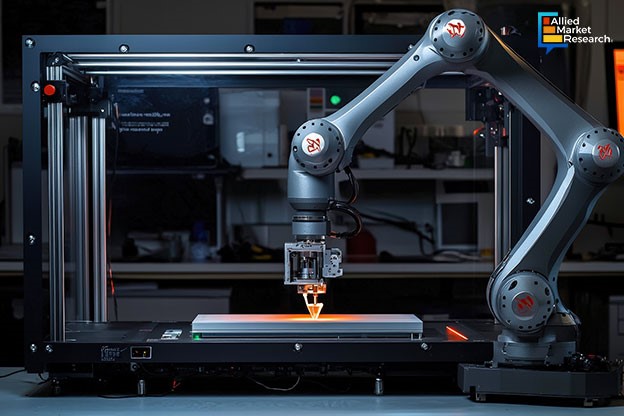Analyzing the Increasing Utility of 3D Printing Gases in Modern Additive Manufacturing Processes

2 Apr
2025
Highlights:
- An introduction to 3D printing gases
- Reasons behind the growing popularity of 3D printing gases
- Product launches and government regulations
Over the years, technological advancements in the manufacturing sector have helped improve the efficiency and productivity of different production processes to maximize the output in the long run. At the same time, there is an increasing emphasis on optimizing the use of raw materials, thus reducing input costs and enhancing the profit margin of manufacturing businesses. The various problems faced by traditional production processes with respect to achieving these objectives have led to the advent of innovative techniques like 3D printing that have enabled enterprises to boost their revenue share in the past few years.
Increasing applicability of 3D printing gases, accelerating sectoral growth
3D printing is a type of additive manufacturing methodology that involves the construction of a product from a three-dimensional, CAD-developed model. It is a group of processes in which the raw materials like polymer or rubber are deposited layer by layer and then joined and solidified using computer control software programs. To perform these procedures seamlessly, manufacturers generally create a regulated environment inside the industrial facility to avoid the influence of external factors like temperature, humidity, pressure changes, etc., from impacting the quality of the product. For this, specialized gases like nitrogen, argon, helium, carbon dioxide, and hydrogen are used. Their application and utility depend on the type of 3D printing techniques employed, such as Stereolithography (SLA), Direct Metal Laser Sintering (DMLS), and Selective Laser Sintering (SLS).
Argon, for instance, has become one of the most widely used elements in additive manufacturing processes. It is primarily used to create an inert atmosphere, especially during power production operations. Moreover, argon is also utilized to displace oxygen during printing procedures to maintain the quality of the finished product. Similarly, the applicability of nitrogen has surged owing to its non-reactive nature. Many manufacturing companies have started installing on-site nitrogen generation systems to ensure a steady supply of the gas and streamline their business cycles. Research studies have shown that the use of nitrogen gas in 3D printing helps prevent discoloration, oxidation, and even combustion of finished products, thereby improving their quality significantly.
Governmental support and investments by private players are helping the industry flourish
The 3D printing gases industry accounted for $63.1 million in 2023 and is predicted to gather a revenue of $166.9 million by 2033, rising at a CAGR of 10.3% during 2024-2033. Several governments across the globe have launched initiatives and enacted regulations to streamline the use of 3D printing gases in additive manufacturing processes. For instance, the UK Government, in April 2024, introduced export control regimes for 3D printers using inert gases for production processes. Under this new system, companies will have to obtain licenses to ship the products outside the country and EU in the coming period.
On the other hand, the launch of innovative products by leading companies in the industry has created favorable conditions for the growth of the sector. In March 2024, for example, Air Liquide, a leading industrial gas supplier, unveiled a new range of high-purity gases for 3D printing and additive manufacturing technologies, such as stereolithography and laser sintering. The two new products, viz., ALPHAGAZ™ 1 and ALPHAGAZ™ 2, have been developed specifically for laboratory purposes and process control applications in advanced manufacturing techniques.
Winding up, the growth of the 3D printing gases market is attributed to the rising adoption of additive manufacturing techniques such as 3D printing in various end-use industries. Furthermore, the increasing utility of inert gases such as argon and nitrogen in various production processes has broadened the scope of the sector. In addition, the governmental support offered in various countries and the launch of different products by leading players are anticipated to boost the revenue share of the landscape in the future.
Get in touch with our experts for the latest trends and advancements in the industry!

Akhilesh Prabhugaonkar
Author's Bio- Akhilesh Prabhugaonkar holds a bachelor’s degree in Electronics Engineering from the reputed Vishwakarma Institute of Technology. He has a special interest in the fields of forensics, world history, international relations and foreign policy, sports, agriculture, astronomy, security, and oceanography. An ardent bibliophile and melophile, Akhilesh loves to write on topics of his interest and various other societal issues. This love for writing made him enter the professional world of content writing and pursue his career in this direction.
Avenue: Entire Library membership of Allied Market Research Reports at your disposal
- Avenue is an innovative subscription-based online report database.
- Avail an online access to the entire library of syndicated reports on more than 2,000 niche industries and company profiles on more than 12,000 firms across 11 domains.
- A cost-effective model tailored for entrepreneurs, investors, and students & researchers at universities.
- Request customizations, suggest new reports, and avail analyst support as per your requirements.
- Get an access to the library of reports at any time from any device and anywhere.
Related Post
-
How are Submarine Cables Transforming Global Connectivity with Enhanced User Experience?
-
Endoscopy Procedures: Transformations in Techniques and Applications
-
AI-Powered Video Analytics: How the Product Actually Works for enterprises
-
Painting Robots: Transforming Precision Coating and Creative Applications
-
Innovations in Pharmacovigilance Systems Advancing Patient Safety
-
Understanding Edge Security: Keeping Data Safe Near the Source
-
Exploring the Use and Advancements of 3D Laser Scanners in Professional Applications
-
Reinforcing Industrial Controls with Smarter Tools and Training








